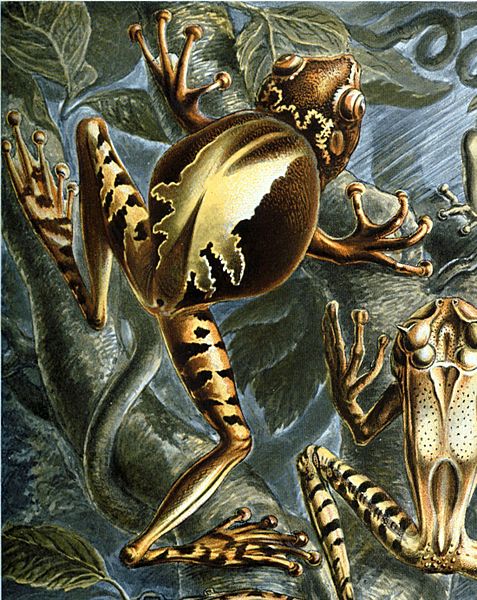Image: Haeckel Batrachia (detail Gastrotheca ovifera)

Description: Notodelphys ovifera (Weinland) = Gastrotheca ovifera (Lichtenstein & Weinland, 1854) Hyla meridionalis (Boulenger) = Hyla meridionalis Boettger, 1874 Hyla tuberculosa (Boulenger) = Ecnomiohyla tuberculosa (Boulenger, 1882) Amphignathodon Güntheri (Boulenger) = Gastrotheca guentheri (Boulenger, 1882) Rhacophorus pardalis (Wallace) = Rhacophorus pardalis Günther, 1858 Hylodes lineatus (Schneider) = Lithodytes lineatus / Leptodactylus lineatus (Schneider, 1799) Limnodytes erythraeus (Duméril) = Hylarana erythraea (Schlegel, 1837) Ceratobatrachus Güntheri (Boulenger) = Ceratobatrachus guentheri Boulenger, 1884 Breviceps mossambicus (Peters) = Breviceps mossambicus Peters, 1854 Lithobates pipiens (Linné) = Rana pipiens (Schreber, 1782)Full text description (in German): English translation: [Remarks made by the translator are in italics or square brackets] Fig. 1. The pouch frog of Venezuela is remarkable for its female's possession of a paired dorsal [back] pouch, in which the eggs remain until the hatching of the tadpoles. A narrow triangular gap at the rear of the back (in the centre of the lightly coloured saddle patch) leads to the pouch. Fig. 2.Mediterranean Tree Frog, Stripeless Tree Frog The treefrog of North Africa and Southern Europe is little different from our native common green treefrog (Hyla arborea) and like the latter lives on trees and shrubs. When crying [calling], the male pushes forward the vocal sac like a bubble. Fig. 3. The treefrog of Ecuador is characterised by the crude build of its thick fingers (with very wide contact plates) and the knobbly skin, that like in toads is covered in glandular warts. Fig. 4. The climbing frog of Ecuador is among the slimmest and most supple forms of treefrogs; his extraordinarily thin and long limbs (with zebralike dark stripes across) enable it of the most dexterous climbing arts. Fig. 5. The flying frog of Borneo is remarkable above all other Batrachids for its extraordinarily widened foot webbings between the elongated toes. If the flying frog spreads these webs while jumping from tree to tree, he can use them as a parachute, similar to the flying dragon (Draconellus) among the reptiles (Plate 79) and the flying squirrels (Pteromys) among the rodents. Fig. 6. The military frog of Surinam is very peculiar in that the female carries its young on its back in military rank. The little tadpoles, numbering 12 to 20, attach to two diverging back ridges of the mother (that run symmetrically either side of the dorsal central line) by their oral suction plates. The mobile rudder tails are turned outward, on the left side as on the right. Fig. 7. The banded frog of Java has two parallel white bands on its back, running lengthwise, that contrast strongly against the dark red brown base colour. The jumping treefrog is about to capture an insect with its protruded bicornuated tongue. Fig. 8. The tip frog from the Solomon Islands is assigned to the group of "horn frogs" that are distinguished by a pair of sharp horns on top of the triangular head; these are elongated coverings of the upper eye lids. The bright colouration and patterning of this horn frog is most variable and often adapted to its environment. Fig. 9. The thickhead frog from East Africa (Mozambique, Sambesi) deviates from all other frogs in the appearance of its very short and thick head. Furthermore, it cannot jump with its short and weak legs, and moves its fat, crude body only with difficulty. The hind feet have large, spade-like digging swellings that help it to rapidly dig itself into the soil. It feeds on termites and in its subterranean habits is equal to the moles. Fig. 10. Northern Leopard Frog The piping frog of North America. Right behind the eye, one can see the large white, entirely superficially positioned eardrum.
Title: Haeckel Batrachia (detail Gastrotheca ovifera)
Credit: Kunstformen der Natur (1904), plate 68: Batrachia (see here, here and here)
Author: Ernst Haeckel
Permission: Public domainPublic domainfalsefalse This work is in the public domain in its country of origin and other countries and areas where the copyright term is the author's life plus 70 years or fewer. You must also include a United States public domain tag to indicate why this work is in the public domain in the United States. Note that a few countries have copyright terms longer than 70 years: Mexico has 100 years, Jamaica has 95 years, Colombia has 80 years, and Guatemala and Samoa have 75 years. This image may not be in the public domain in these countries, which moreover do not implement the rule of the shorter term. Côte d'Ivoire has a general copyright term of 99 years and Honduras has 75 years, but they do implement the rule of the shorter term. Copyright may extend on works created by French who died for France in World War II (more information), Russians who served in the Eastern Front of World War II (known as the Great Patriotic War in Russia) and posthumously rehabilitated victims of Soviet repressions (more information). This file has been identified as being free of known restrictions under copyright law, including all related and neighboring rights. https://creativecommons.org/publicdomain/mark/1.0/PDMCreative Commons Public Domain Mark 1.0falsefalse
Usage Terms: Public domain
License: Public domain
Attribution Required?: No
Image usage
The following page links to this image:

